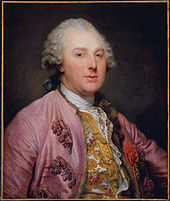Charles Claude Flahaut de La Billarderie

Charles Claude Flahaut de La Billarderie, comte d'Angiviller (born January 24, 1730 in Saint-Remy-en-l'Eau im Beauvaisis , † December 11, 1809 in Altona , today Hamburg ) was a French military man, politician and director of royal building management under Louis XVI.
Life
The Comte d'Angivillers was a friend of Louis XVI. and was appointed directeur général des Bâtiments, Arts, Jardins et Manufactures de France by him in 1774 , the most important position within the royal administration for official art policy. During his tenure (until 1790) the first ideas for creating a national museum in the Louvre were developed after the gallery of the Jardin du Luxembourg was closed again in 1779 after almost twenty years. To this end, d'Angivillers strengthened the royal collections, among other things, through a committed purchasing policy, which was still under Louis XV. had subsided, and particularly promoted the French history painting . He left France in 1790. In April 1796 he came to Kiel and later to Gut Emkendorf . As a follower of absolutism he came into opposition to the Count Reventlow. He later spent his twilight years in a monastery in Altona.
literature
- Jacques Silvestre de Sacy: Le Comte d'Angiviller, dernier directeur général des Bâtiments du Roi . Éditions d'histoire et d'art, Plon, Collection ″ Ars et historia ″, Paris 1953.
- Jean de Viguerie: Histoire et dictionnaire du temps des Lumières. 1715-1789 . Robert Laffont, Bouquins collection, Paris 2003, ISBN 2221048105 .
Individual evidence
- ↑ Life data from: Oeuvres de Lavoisier, 1770–1775, p. 874.
- ↑ alternatively in the house of the Catholic pastor Versen in Altona. , Cf. Klaus Lemke-Paetznick, Church in Revolutionary Time: The State Church in Schleswig and Holstein , p. 171.
| personal data | |
|---|---|
| SURNAME | Flahaut de La Billarderie, Charles Claude |
| ALTERNATIVE NAMES | Flahaut de La Billarderie, Charles Claude comte d'Angiviller |
| BRIEF DESCRIPTION | French military, politician, director of the royal building management under Louis XVI. |
| DATE OF BIRTH | January 24, 1730 |
| PLACE OF BIRTH | Saint-Remy-en-l'Eau , Beauvaisis |
| DATE OF DEATH | December 11, 1809 |
| Place of death | Altona , today Hamburg |